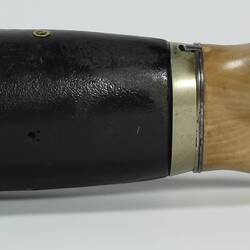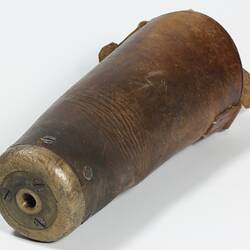Summary
Alternative Name(s): Prosthesis, Artificial Arm, Artificial Limb
Wooden prosthetic arm with flexible fingers. In wooden box with accessories: socket, knife and fork. Slot on hand allows the knife or fork to be slotted in. Believed to have been made by J. Gillingham in Britain circa 1914-1916.
A retired 90-year-old prosthetics maker informed the curator that 'after 1916 the quality of prostheses deteriorated because of the demand', which the curator took to mean that 1916 was a likely latest date for this example. It may therefore have been made for a wounded World War I soldier, although further provenance is unknown.
James Gillingham was a cobbler from Chard, England. He first made an artificial limb for a gamekeeper who had his arm amputated at the shoulder in 1863. The arm was a success, and Gillingham went on to mould leather arms with attachments for thousands of people, establishing a substantial business. By 1910 he had assisted over 15,000 patients, documenting many of them in his studio. (The Science Museum in London holds a collection of his photographs.) During World War I many disabled ex-servicemen received artificial limbs made in Chard. After Gillingham died in 1924, his son Sidney and grandson Geoffrey continued with the business until 1950, when it was sold. The company closed in the 1960s.
Physical Description
Hand made of blonde wood with individual finger-joints. Hand has exquisitely jointed finger and thumb sections. Leather socket fits on stump of forearm. Forearm to wrist section is hardened leather, black painted.
More Information
-
Collecting Areas
-
Acquisition Information
Donation from Australian Medical Association of Victoria (AMA) Medical Museum
-
Maker
-
Classification
-
Category
-
Discipline
-
Type of item
-
Overall Dimensions
50 cm (Length)
-
Exhibition Collection Management
50 mm (Length)
-
References
Information on James Gillingham from: Chard Museum web site [Link 1] accessed 12/8/2014 BBC web site [Link 2] accessed 12/8/2014. The site depicts a very similar arm to that held by Museum Victoria. Gillinghams (company), Science Museum, London, [Link 3] accessed 24/4/2024. Mary Guyatt, 'Better Legs: Artificial Limbs for British Veterans of the First World War', Journal of Design History, vol. 14, no. 4, 2001. Warren, Derrick, James Gillingham, surgical mechanist & manufacturer of artificial limbs ; Somerset: Somerset Industrial Archeologocial Society, 2001.
-
Keywords
Medical Apparatus & Instruments, Prostheses, World War I, 1914-1918




